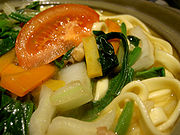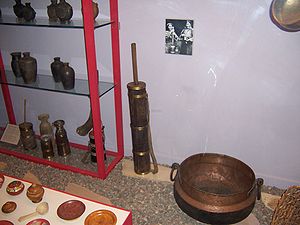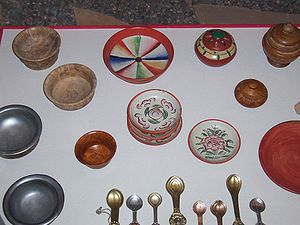
Cuisine of Tibet
Encyclopedia
Tibetan cuisine reflects local climes and customs. Few crops grow at the high altitudes that characterize Tibet
, although a few areas in Tibet are low enough to grow such crops as rice, oranges, bananas, and lemon. The most important crop is barley
. Flour milled from roasted barley, called tsampa
, is the staple food
of Tibet. Balep is Tibetan bread eaten for breakfast and lunch. Thukpa is mainly consumed for dinner. It consists of noodles of various shapes, vegetables and meat in broth. Tibetan cuisine is traditionally served with bamboo chopsticks
, in contrast to other Himalayan
cuisines, which are eaten by hand. Small soup bowls are also used, and rich Tibetans fed from bowls of gold and silver.
Meat
dishes are likely to be yak
, goat
, or mutton, often dried, or cooked in a spicy stew
with potato
es. Mustard seed
is cultivated in Tibet, and therefore features heavily in its cuisine. Yak yoghurt
, butter
and cheese
are frequently eaten, and well-prepared yoghurt is considered something of a prestige item. As well as consumed in Tibet, varieties of Tibetan dishes are consumed in Ladakh
, Sikkim
, Arunachal Pradesh
and by the Tibetan diaspora
in India
, and various regions of northern Nepal
, such as Mustang
.

Others include Sokham Bexe
, Drokpa Katsa
, Lunggoi Katsa
, Tu (cake)
, Masan
, Xogoi Momo
, Papza Mogu
, Samkham Papleg
, Gyabrag
, Chetang Goiche
, Cheser Mog
, Zhoima Mogu
, Yurla
, Zhoixo, Chexo, Gyatog
, Gyaho
, Xabbatog
, Gong'a Momo
, Xab Momo
, Xab Pagri, Gundain
and Qoiri
.
In larger Tibetan towns and cities many restaurants now serve Sichuan-style Chinese food. Western imports and fusion dishes, such as fried yak and chips, are also popular. Nevertheless, many small restaurants serving traditional Tibetan dishes persist in both cities and the countryside.
 Most Tibetans drink many cups of yak butter tea
Most Tibetans drink many cups of yak butter tea
each day. Jasmine tea
is also sometimes available.
Alcoholic beverages include:

Tibet
Tibet is a plateau region in Asia, north-east of the Himalayas. It is the traditional homeland of the Tibetan people as well as some other ethnic groups such as Monpas, Qiang, and Lhobas, and is now also inhabited by considerable numbers of Han and Hui people...
, although a few areas in Tibet are low enough to grow such crops as rice, oranges, bananas, and lemon. The most important crop is barley
Barley
Barley is a major cereal grain, a member of the grass family. It serves as a major animal fodder, as a base malt for beer and certain distilled beverages, and as a component of various health foods...
. Flour milled from roasted barley, called tsampa
Tsampa
Tsampa is a Tibetan staple foodstuff, particularly prominent in the central part of the region. It is roasted flour, usually barley flour and sometimes also wheat flour or rice flour...
, is the staple food
Staple food
A staple food is one that is eaten regularly and in such quantities that it constitutes a dominant portion of a diet, and that supplies a high proportion of energy and nutrient needs. Most people live on a diet based on one or more staples...
of Tibet. Balep is Tibetan bread eaten for breakfast and lunch. Thukpa is mainly consumed for dinner. It consists of noodles of various shapes, vegetables and meat in broth. Tibetan cuisine is traditionally served with bamboo chopsticks
Chopsticks
Chopsticks are small, often tapered, sticks used in pairs of equal length as the traditional eating utensils of China and its diaspora, Japan, Korea, Vietnam and Northern provinces of Laos, Thailand and Burma. Generally believed to have originated in ancient China, they can also be found in some...
, in contrast to other Himalayan
Himalayas
The Himalaya Range or Himalaya Mountains Sanskrit: Devanagari: हिमालय, literally "abode of snow"), usually called the Himalayas or Himalaya for short, is a mountain range in Asia, separating the Indian subcontinent from the Tibetan Plateau...
cuisines, which are eaten by hand. Small soup bowls are also used, and rich Tibetans fed from bowls of gold and silver.
Meat
Meat
Meat is animal flesh that is used as food. Most often, this means the skeletal muscle and associated fat and other tissues, but it may also describe other edible tissues such as organs and offal...
dishes are likely to be yak
Yak
The yak, Bos grunniens or Bos mutus, is a long-haired bovine found throughout the Himalayan region of south Central Asia, the Tibetan Plateau and as far north as Mongolia and Russia. In addition to a large domestic population, there is a small, vulnerable wild yak population...
, goat
Goat
The domestic goat is a subspecies of goat domesticated from the wild goat of southwest Asia and Eastern Europe. The goat is a member of the Bovidae family and is closely related to the sheep as both are in the goat-antelope subfamily Caprinae. There are over three hundred distinct breeds of...
, or mutton, often dried, or cooked in a spicy stew
Stew
A stew is a combination of solid food ingredients that have been cooked in liquid and served in the resultant gravy. Ingredients in a stew can include any combination of vegetables , meat, especially tougher meats suitable for slow-cooking, such as beef. Poultry, sausages, and seafood are also used...
with potato
Potato
The potato is a starchy, tuberous crop from the perennial Solanum tuberosum of the Solanaceae family . The word potato may refer to the plant itself as well as the edible tuber. In the region of the Andes, there are some other closely related cultivated potato species...
es. Mustard seed
Mustard seed
Mustard seeds are the small round seeds of various mustard plants. The seeds are usually about 1 or 2 mm in diameter. Mustard seeds may be colored from yellowish white to black. They are important spices in many regional foods. The seeds can come from three different plants: black mustard , brown...
is cultivated in Tibet, and therefore features heavily in its cuisine. Yak yoghurt
Yoghurt
Yoghurt, yogurt or yogourt is a dairy product produced by bacterial fermentation of milk. The bacteria used to make yoghurt are known as "yoghurt cultures"...
, butter
Butter
Butter is a dairy product made by churning fresh or fermented cream or milk. It is generally used as a spread and a condiment, as well as in cooking applications, such as baking, sauce making, and pan frying...
and cheese
Tibetan cheese
Tibetan cheese is an important part of Tibetan cuisine. Soft cheese curds resembling cottage cheese, made from buttermilk, are called chura loenpa . Hard cheese is called chura kampo. Extra hard cheese, made from solidified yoghurt, is called chhurpi, and is also found in Sikkim and Nepal...
are frequently eaten, and well-prepared yoghurt is considered something of a prestige item. As well as consumed in Tibet, varieties of Tibetan dishes are consumed in Ladakh
Ladakh
Ladakh is a region of Jammu and Kashmir, the northernmost state of the Republic of India. It lies between the Kunlun mountain range in the north and the main Great Himalayas to the south, inhabited by people of Indo-Aryan and Tibetan descent...
, Sikkim
Sikkim
Sikkim is a landlocked Indian state nestled in the Himalayan mountains...
, Arunachal Pradesh
Arunachal Pradesh
Arunachal Pradesh is a state of India, located in the far northeast. It borders the states of Assam and Nagaland to the south, and shares international borders with Burma in the east, Bhutan in the west, and the People's Republic of China in the north. The majority of the territory is claimed by...
and by the Tibetan diaspora
Tibetan diaspora
The Tibetan diaspora is a term used to refer to the communities of Tibetan people living outside Tibet. Tibetan emigration happened in two waves: one in 1959 following the 14th Dalai Lama's self-exile in India, and the other in the 1980s when Tibet was opened to trade and tourism. The third wave...
in India
India
India , officially the Republic of India , is a country in South Asia. It is the seventh-largest country by geographical area, the second-most populous country with over 1.2 billion people, and the most populous democracy in the world...
, and various regions of northern Nepal
Nepal
Nepal , officially the Federal Democratic Republic of Nepal, is a landlocked sovereign state located in South Asia. It is located in the Himalayas and bordered to the north by the People's Republic of China, and to the south, east, and west by the Republic of India...
, such as Mustang
Mustang District
Mustang District, a part of Dhawalagiri Zone, is one of the seventy-five districts of Nepal, a landlocked country of South Asia. The district, with Jomsom as its headquarters, covers an area of 3,573 km² and has a population of 14,981....
.
Dishes
Other Tibetan foods include:
- Sha Balep - a bread stuffed with seasoned beef and fashioned into semi-circular or circular shapes and which according to regional variations is either deep fried or pan fried like pot stickers.
- Balep korkunBalep korkunBalep korkun is a type of bread that is consumed mainly in central Tibet. It is round, flat and relatively easy to make. The ingredients are tsampa , water and baking powder. It is cooked in a frying pan.-References:*...
- a central Tibetan flatbreadFlatbreadA flatbread is a simple bread made with flour, water, and salt and then thoroughly rolled into flattened dough. Many flatbreads are unleavened: made without yeast or sourdough culture: although some flatbread is made with yeast, such as pita bread....
cooked on a skillet rather than in an oven. - Tingmo (food) - a type of steamed bun, a heavier version of the Chinese baoziBaoziA bāozi or simply known as bao, bau, humbow, nunu, bausak, pow or pau is a type of steamed, filled bun or bread-like item in various Chinese cuisines, as there is much variation as to the fillings and the preparations...
. - ThenthukThenthukThenthuk is a very common noodle soup, especially in Amdo, Tibet where it is served as dinner and sometimes lunch. The main ingredients are wheat flour dough, mixed vegetables and some pieces of mutton or yak meat...
- a type of cold-weather soupSoupSoup is a generally warm food that is made by combining ingredients such as meat and vegetables with stock, juice, water, or another liquid. Hot soups are additionally characterized by boiling solid ingredients in liquids in a pot until the flavors are extracted, forming a broth.Traditionally,...
made with noodles and various vegetables. - Shab Tra - Stir-fried meat tossed with celery, carrots and fresh green chili.
- Gyurma (Juema) - Tibetan blood sausages with yak or sheep's blood and roasted barley flour or rice as filler
- De-Thuk - a type of soup that includes yak or sheep stock along with rice, different types of Tibetan cheeses and droma which is a type of tibetan root.
- Tsam-thuk - a type of soup that uses yak or sheep stock and roasted barley flour as well as a variety of Tibetan cheeses.
- Dre-si - Tibetan sweet dish using rice that is cooked in unsalted butter and mixed with raisins, droma (gourd shaped root found in Tibet), dates and other nuts. This dish is usually served only on Losar (Tibetan new year).
- Khapsey - Tibetan cookies or biscuits that is deep fried and usually made during celebrations such as the Tibetan new year or weddings. Khapseys are fashioned into many different intricate shapes and textures. Some are sprinkled with powdered sugar while other shapes such as the donkey ear-shaped khapseys are used for decoration.
Others include Sokham Bexe
Sokham Bexe
In Tibetan cuisine, Sokham Bexe is a fried dough, with butter and minced meat. It is said to be a favourite of the Dalai Lama and the Panchen Lama....
, Drokpa Katsa
Drokpa Katsa
In Tibetan cuisine, Drokpa Katsa is stewed tripe, with curry, fennel, monosodium glutamate and salt....
, Lunggoi Katsa
Lunggoi Katsa
In Tibetan cuisine, Lunggoi Katsa is stewed sheep's head, with curry, fennel, monosodium glutamate and salt....
, Tu (cake)
Tu (cake)
In Tibetan cuisine, Tu is a cheese cake, made with yak butter, brown sugar and water, made into a pastry....
, Masan
Masan (pastry)
In Tibetan cuisine, Masan is a pastry, made with tsampa, dry cubic or curd cheese, yak butter, brown sugar and water....
, Xogoi Momo
Xogoi Momo
In Tibetan cuisine, Xogoi Momo is a mashed potato, with dough shaped into balls with a minced meat filling, served with breadcrumbs....
, Papza Mogu
Papza Mogu
In Tibetan cuisine, Papza Mogu is a dough shaped into balls with melted butter, brown sugar and dry curd cheese. It gives a sweet and sour taste and is red in color....
, Samkham Papleg
Samkham Papleg
In Tibetan cuisine, Samkham Papleg is a fried dough with yak butter or rapeseed oil....
, Gyabrag
Gyabrag
In Tibetan cuisine, Gyabrag is a pancake, made with barley flour, yak butter, dry cheese curds and sugar....
, Chetang Goiche
Chetang Goiche
In Tibetan cuisine, Chetang Goiche are strips of dough, fried with rapeseed oil and brown sugar.....
, Cheser Mog
Cheser Mog
In Tibetan cuisine, Cheser Mog is rice, with melted yak butter, brown sugar, raisins and salt....
, Zhoima Mogu
Zhoima Mogu
In Tibetan cuisine, Zhoima Mogu is wild ginseng, with melted yak butter and sugar....
, Yurla
Yurla
In Tibetan cuisine, Yurla is a wheat pastry with butter, particularly common in Nyainrong County in northern Tibet....
, Zhoixo, Chexo, Gyatog
Gyatog
In Tibetan cuisine, Gyatog are noodles, much like those of the Han variety, made with eggs, flour and bone soup....
, Gyaho
Gyaho
In Tibetan cuisine, Gyaho is a chafing dish in the Han style; a hot pot of vermicelli, sea tangle, mushrooms, meat balls, bamboo spouts and salt. It has special significance, generally eaten by senior monks during important ceremonies....
, Xabbatog
Xabbatog
In Tibetan cuisine, Xabbatog is a dough stuffed with shredded turnips and dry curd cheese and cooked with bone soup....
, Gong'a Momo
Gong'a Momo
In Tibetan cuisine, Gong'a Momo is a fried dough made with eggs and flour and stuffed with meat paste....
, Xab Momo
Xab Momo
In Tibetan cuisine, Xab Momo is a bun, usually baked or steamed, stuffed with beef or mutton....
, Xab Pagri, Gundain
Gundain
In Tibetan cuisine, Gundain is a type of pastry made from barley grain and yeast , with tsampa, dry curd cheese, wild ginseng and brown sugar. This pastry is often served during the Tibetan New Year and Losar as a starter....
and Qoiri
Qoiri
In Tibetan cuisine, Qoiri is a stew of mutton chops, made with flour, shredded wheat, chillies, dry curd cheese, water and salt.The Moinba people of southwestern Tibet often add a stronger cheese and add further ingredients such as wild mushrooms and fungi....
.
In larger Tibetan towns and cities many restaurants now serve Sichuan-style Chinese food. Western imports and fusion dishes, such as fried yak and chips, are also popular. Nevertheless, many small restaurants serving traditional Tibetan dishes persist in both cities and the countryside.
Beverages

Butter tea
Butter tea, also known as po cha , cha süma , Mandarin Chinese: sūyóu chá or goor goor in local Ladakhi terms, is a drink of the Tibetans and Chinese minorities in southwestern China. It is also consumed in Bhutan. It is made from tea leaves, yak butter, and salt.-Usage:Drinking butter tea is a...
each day. Jasmine tea
Tea
Tea is an aromatic beverage prepared by adding cured leaves of the Camellia sinensis plant to hot water. The term also refers to the plant itself. After water, tea is the most widely consumed beverage in the world...
is also sometimes available.
- "Brick tea is made by methods only distantly related to those employed in China or Ceylon. When the water boils, a great handful of the stuff is crumbled into it and allowed to stew for between five and ten minutes, until the whole infusion is so opaque that it looks almost black. At this stage a pinch of salt is added; the Tibetans always put salt, never sugar, in their tea. I have been told that they sometimes add a little sodaSodium bicarbonateSodium bicarbonate or sodium hydrogen carbonate is the chemical compound with the formula Na HCO3. Sodium bicarbonate is a white solid that is crystalline but often appears as a fine powder. It has a slightly salty, alkaline taste resembling that of washing soda . The natural mineral form is...
, in order to give the beverage a pinkish tinge, but I never saw this done in Sikang. They very seldom, on the other hand, drink tea without butter in it. If you are at home, you empty the saucepan into a big wooden churn, straining the tea through a colander made of reed or horsehair. Then you drop a large lump of butter into it, and, after being vigorously stirred, this brew is transferred to a huge copper teapot and put on a brazier to keep it hot. When you are traveling, you do not normally take a churn with you, so everyone fills his wooden bowl with tea, scoops a piece of butter out of a basket, puts it in the bowl, stirs the mixture gently with his finger, and, finally, drinks the tea."
Alcoholic beverages include:
- ChangChhaangChhaang or chang is a Tibetan/Sherpa/Limbu/Newari alcoholic beverage also popular in parts of eastern Himalayas.-Geographical prevalence:...
, a beer usually made from barley - Pinjopo, a rice wine
- AraAra (drink)Ara, or Arag, is a traditional alcoholic beverage consumed in Bhutan. Ara is made from rice, maize, millet, or wheat, and may be either fermented or distilled. The beverage is usually a clear, creamy, or white color.-Production:Ara is most commonly made from rice or maize at private homes or farms...
, distilled or fermented grain alcohol


